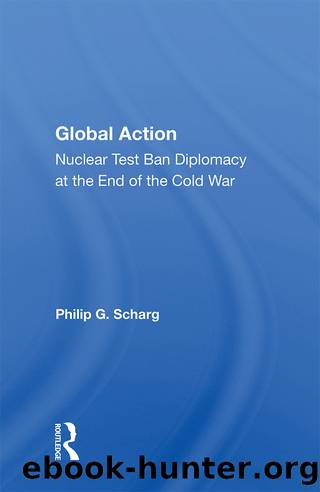Global Action: Nuclear Test Ban Diplomacy at the End of the Cold War by Philip G. Schrag

Author:Philip G. Schrag [Schrag, Philip G.]
Language: eng
Format: epub
Tags: Globalization, Political Science, General
ISBN: 9780429710438
Google: P96iDwAAQBAJ
Goodreads: 51858623
Publisher: Routledge
Published: 1992-06-01T00:00:00+00:00
Duration
As noted, all countries' delegates were keenly aware that the most important procedural issue was whether the Conference would end (with or without a vote on an Amendment) in January, 1991, or whether it would become an ongoing international institution as PGA had planned. No one expected the United States and Britain to reverse themselves and permit negotiation of any sort of amendment. But by the same token, many nonaligned states did not want the Conference to end without putting continuing pressure on the American and British governments, and they hoped to continue the Conference in some way past Januaryâeither minimally, by having a second session in 1992 or 1993, with at least one further session on the eve of the NPT extension meeting in 1995, or more ambitiously, by having continuing committee work take place between sessions as well. They therefore wanted rules or other understandings that would explicitly allow a majority to vote for a recess of the Conference to a later time (despite the depositaries having convened the Conference for a period to end January 18). But this issue would be so contentious as to be incapable of resolution until it had to be resolved, at the Conference itself. As one delegate said, "the climate is too difficult to raise hard issues now. Every small thing is so difficult, like the issue of who will open the meeting. We will just have to let the important issues go until the Conference itself."
Legally, two different aspects of the emerging rules of procedure were implicated. First, one of the Seabed Treaty Review Conference Rules gave highest precedence to a motion to "suspend the meeting".74 This rule was accepted without discussion or controversy by delegates to the Meeting on the first day that the rules were discussed. But what did it mean to suspend the Conference? Would a suspension have to be limited to a period of time within the period for which the Conference had been called by the depositary governments, or could it be suspended for a year or two? Second, whether or not the "suspension" rule was the pertinent text to be interpreted, by what mechanism could the Conference decide to continue itself beyond 1991? The voting rules for the Conference would probably be determinative, which is why so much attention was given, on all sides, to the Canadian proposal for deciding whether issues required majority or super-majority voting.
On another level, however, the issue of duration was not primarily a legal one at all, but an economic one. Most delegations believed that the Conference would probably be another fruitless exercise in the long testban history; given the probability that George Bush would be President of the United States through 1996, they were loathe to expend the financial and human resources necessary for multiple head-bashings. The fact that the United States had refused to pay its UN-scale share of the expenses of the Secretariat compounded their cost, and the still-implicit threat that the United States and Britain might
Download
This site does not store any files on its server. We only index and link to content provided by other sites. Please contact the content providers to delete copyright contents if any and email us, we'll remove relevant links or contents immediately.
Spell It Out by David Crystal(35852)
Life for Me Ain't Been No Crystal Stair by Susan Sheehan(35539)
Cecilia; Or, Memoirs of an Heiress — Volume 1 by Fanny Burney(32067)
Cecilia; Or, Memoirs of an Heiress — Volume 3 by Fanny Burney(31463)
Cecilia; Or, Memoirs of an Heiress — Volume 2 by Fanny Burney(31413)
The Great Music City by Andrea Baker(30794)
Professional Troublemaker by Luvvie Ajayi Jones(29425)
We're Going to Need More Wine by Gabrielle Union(18640)
Twilight of the Idols With the Antichrist and Ecce Homo by Friedrich Nietzsche(18303)
The Secret History by Donna Tartt(18188)
Cat's cradle by Kurt Vonnegut(14768)
All the Missing Girls by Megan Miranda(14766)
Pimp by Iceberg Slim(13787)
Bombshells: Glamour Girls of a Lifetime by Sullivan Steve(13691)
Fifty Shades Freed by E L James(12923)
Talking to Strangers by Malcolm Gladwell(12887)
Norse Mythology by Gaiman Neil(12846)
The Social Justice Warrior Handbook by Lisa De Pasquale(11957)
Underground: A Human History of the Worlds Beneath Our Feet by Will Hunt(11842)
